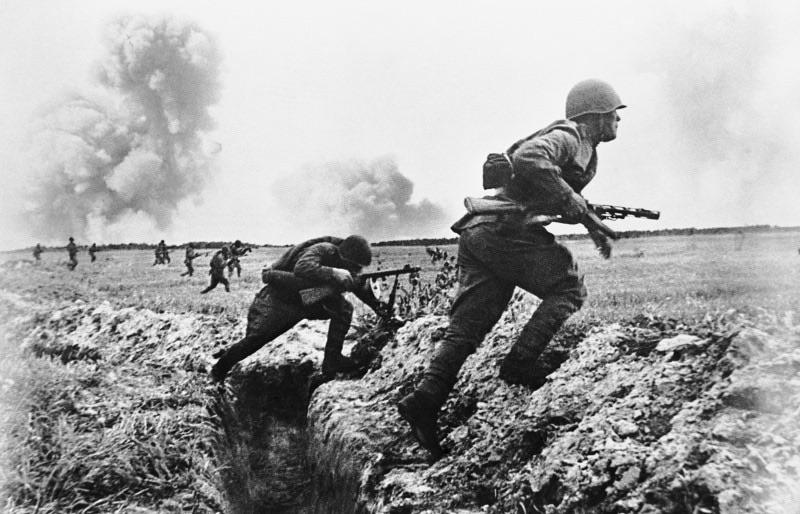Introduction
Operation Bagration was a massive Soviet military offensive launched on June 22, 1944, during World War II. Named after the Georgian Prince Pyotr Bagration, a Russian general from the Napoleonic Wars, the operation aimed to liberate Belarus from Nazi occupation and destroy Army Group Centre, the backbone of German forces on the Eastern Front. The offensive far exceeded D-Day in scale, involving over 2.3 million Soviet troops and leading to one of the most devastating defeats in German military history.
This article explores the planning, execution, key battles, impact, and significance of Operation Bagration, demonstrating how it played a decisive role in the final defeat of Nazi Germany.
Strategic Context
By mid-1944, the Eastern Front had seen significant shifts in momentum. The Red Army had repelled the Germans at Stalingrad (1942-43) and secured major victories at Kursk (1943) and in Ukraine. Meanwhile, the Allies had landed in Normandy on June 6, 1944 (D-Day), forcing Hitler to divert resources to the Western Front. Stalin sought to capitalize on this by launching a colossal offensive in the East, crippling German forces and accelerating the end of the war.
Objectives of Operation Bagration
- Destroy Army Group Centre – Germany’s most powerful force in the East.
- Liberate Belarus – A key German-occupied Soviet territory.
- Advance toward Poland and Eastern Europe – Setting the stage for an invasion of Germany.
- Coordinate with the Western Allies – To prevent German reinforcements from shifting to France.
Forces Involved
Soviet Strength
The Soviet Union assembled a massive force for the operation:
- 2.3 million soldiers
- 36,400 artillery pieces
- 5,300 tanks and self-propelled guns
- 5,300 aircraft
This force was organized into four fronts (army groups):
- 1st Baltic Front (General Bagramyan)
- 1st Belorussian Front (Marshal Rokossovsky)
- 2nd Belorussian Front (General Zakharov)
- 3rd Belorussian Front (General Chernyakhovsky)
German Strength
Germany’s Army Group Centre, commanded by Field Marshal Ernst Busch, was ill-prepared for the Soviet onslaught. They had:
- 400,000 soldiers
- 3,000 tanks and self-propelled guns
- 9,500 artillery pieces
- 600 aircraft
Hitler had underestimated Soviet strength and believed the main attack would come in Ukraine, leaving Army Group Centre vulnerable.
Phases of Operation Bagration
1. Soviet Deception (Maskirovka)
The Red Army executed an elaborate deception plan, convincing the Germans that the main attack would occur in the south. Fake troop movements, false radio transmissions, and dummy airfields misled German intelligence.
2. Initial Assault (June 22-28, 1944)
On June 22, 1944—exactly three years after the Nazi invasion of the USSR—the Soviets launched a devastating artillery barrage. This was followed by a blitzkrieg-style combined arms assault with tanks, infantry, and aircraft overwhelming German positions. The key battles were:
- The Battle of Vitebsk: The Soviets encircled and annihilated the German VI Corps.
- The Battle of Bobruisk: Soviet troops trapped 40,000 Germans, killing or capturing nearly all of them.
3. The Collapse of Army Group Centre (June 28 – July 3, 1944)
Within days, the German front lines crumbled. The Soviets used their deep battle doctrine, striking multiple points at once and cutting off German retreats. Major German cities in Belarus fell rapidly:
- Minsk (July 3, 1944): The Soviet 2nd and 3rd Belorussian Fronts encircled 100,000 German troops, leading to a massive defeat.
- Orsha and Mogilev: These critical defensive strongholds fell with ease.
4. Pursuit and Breakthrough (July-August 1944)
After capturing Minsk, the Red Army continued pushing westward. Major advances included:
- Lublin, Poland (July 24, 1944): Opening the path to Warsaw.
- The Destruction of the 4th Army: German remnants suffered tens of thousands of casualties.
By August, the Soviets had advanced 300 miles, liberated Belarus, and reached the outskirts of Warsaw.
Consequences and Impact
German Casualties and Losses
Operation Bagration resulted in one of the most catastrophic defeats for Nazi Germany. The losses were staggering:
- 450,000–550,000 casualties (killed, wounded, or captured)
- 50+ divisions annihilated
- Thousands of tanks, artillery pieces, and aircraft destroyed
This dwarfed German losses in Normandy, where they suffered about 200,000 casualties during the same period.
Soviet Gains
- Belarus liberated
- Poland invaded
- German strategic collapse in the East
- Path cleared to Berlin
Impact on the War
- The End of the Eastern Front for Germany: The destruction of Army Group Centre crippled German defensive capabilities.
- Accelerated the Fall of Nazi Germany: The loss of so many troops and equipment made it impossible for Hitler to halt the Soviet advance.
- Diverted German Resources from the Western Front: Ensuring the success of the Allied landings in France.
- Influence on Post-War Europe: The Soviets’ rapid advance positioned them to control Eastern Europe, shaping the Cold War.
Comparison to D-Day
While D-Day is often celebrated as the turning point of World War II, Operation Bagration was larger and more decisive in crippling Nazi Germany. The key differences:
| Factor | Operation Bagration | D-Day (Normandy Landings) |
|---|---|---|
| Date | June 22 – Aug 19, 1944 | June 6, 1944 (start) |
| Troops Involved | 2.3 million (Soviet) | 1.5 million (Allied) |
| German Casualties | 450,000 – 550,000 | 200,000 |
| Strategic Impact | Destroyed German Army Group Centre, allowing Soviet advance into Poland and Germany | Established Western Front, but took months to break out of Normandy |
Conclusion
Operation Bagration was one of the most significant military campaigns of World War II. The sheer scale of the offensive, the destruction of Army Group Centre, and the liberation of Belarus marked a turning point in the war. While often overshadowed by D-Day, its impact was arguably even greater in hastening Nazi Germany’s defeat.
By December 1944, the Red Army was approaching Berlin, setting the stage for the final battle of World War II in Europe. Operation Bagration stands as a testament to Soviet military strategy, resilience, and the decisive role of the Eastern Front in ending the war.

